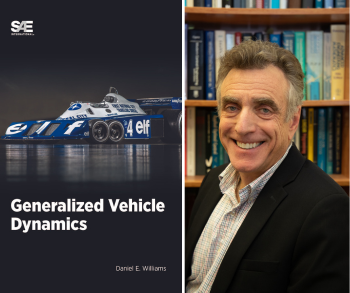Meet the Author: Dan Williams
Posted: July 7, 2023
The road less travelled can lead to incredible outcomes.
In his debut SAE title, Generalized Vehicle Dynamics, author Dan Williams applies a combination of theoretical and practical approaches, and uses conventions not found in other dynamics texts.
Most existing vehicle dynamics literature begins from a two-axle vehicle convention, which can lead to issues regarding other vehicle types, Dan shared. That’s why he chose to focus on a change in conventions that’s led to a more widely applicable system for analyzing vehicle dynamics, taking a look at multi- axle vehicles in addition to two-axle vehicles.
A second variation from most existing vehicle dynamics texts is that Dan uses a control theory based approach. The change in convention is seen to simplify and standardize a control theoretic vehicle model, and traditional characterizations of vehicle handling such as understeer and wheelbase are evident in the steady-state solutions of transient vehicle models. The vehicle becomes a dynamic system that is controlled by either the chassis control systems of ADAS or an autonomous virtual driver.
It’s an approach that stems from Dan’s extensive professional experience as an engineer and leader within the ZF Commercial Vehicle Solutions Group, where he currently serves as Head of Product Innovation in the Americas. With over 30 years of his career spent in engineering and planning positions with increasing responsibility in passenger car suspension and commercial steering business units, Dan was uniquely suited to look at the challenges facing the vehicle from all angles.
This mixture of theory and application has guided Dan throughout his engineering career.
“It’s such a great time to be in vehicle engineering, specifically vehicle dynamics. A lot of emphasis is really on interesting problems, with autonomy and driver assistance systems, problems needed to be solved to be able to get autonomy where we need to go,” Dan said.
When it comes to autonomy, Dan expressed a need for balance regarding human users and artificial intelligences. Autonomy can prevent the vast majority of accidents that can be attributable to driver error, but in rare conditions can possibly introduce new issues.
“The real complexity comes in when how you deal with things like sensor problems, faulty systems,” Dan said.
He emphasized the need to have the human and machine elements operating a vehicle work in unison to achieve a best possible outcome. He cited a quote from Garry Kasparov, world-renowned chess grandmaster describing his experience facing off against supercomputer opponents, as an example of how to achieve this.
“In his Ted Talk, Kasparov says, “work well with intelligent machines, to guide them as they become specialized experts, and to ask the right questions,’” Dan said. “That’s the way we need to think about automated vehicles.”
He urges new professionals to challenge themselves with theory while exposing themselves to opportunities for practical application.
“They are both extremely interesting on their own. You can get absorbed in either domain, but when they work together, you can do amazing things,” Dan said.
Check out Generalized Vehicle Dynamics today, and keep up with Dan and our friends at ZF Group, and for more news on automation on their website.
